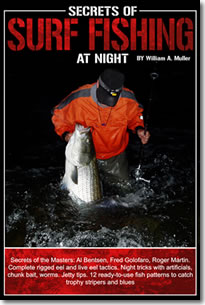| Striped Bass Skin Disease |
| Written by John Redmond |
|
Subject: Clarification on Striped Bass Skin Disease May 3, 2006 MarineFisheries Advisory UPDATE TO SALTWATERANGLERS ABOUT STRIPED BASS SKIN DISEASE The striped bass skindisease reported in a recent Boston Globe article is not a new disease to fishbiologists and is not considered a serious health risk by regional publichealth agencies. It is known as Mycobacteriosisand was first identified on striped bass in Chesapeake Bay in 1997. Fish that contract this disease develop a bacterial infection that results in inflammation, tissuedestruction and formation of scar tissue in one or more organs. While Mycobacteriosis can be transmitted to humans throughdirect contact with infected fish or water, this disease can be treated with antibiotics; the bacteria responsible for this disease are not flesh-eating. Any persons with questions or concerns should contact a physician. Myobacteriosisin StripedBass Signs of infection in striped bass are first noted in internal organs suchas the spleen and kidney. Nodules (called granulomas) composed of inflammatorycells and fibrous connective tissue form in response to the bacteria in anattempt to stop the infection. An increase in the number and size of granulomasleads to the formation of extensive scar tissue and eventual loss of normaltissue architecture. This disease progresses slowly in fish and has beencharacterized as a “wasting disease” due to loss of body mass andemaciation. Striped bass may contract the disease because of weakened healthcaused by poor water quality and forage-relatedissues in Chesapeake Bay. Many stripedbass from Chesapeake Bay reside in coastal waters of Massachusetts betweenMay-October. However, MarineFisherieshas not received any reports of external lesions and has not observed anyinternal signs of the disease in fish examined over the last two years. We are unsure why the disease has not been observed in Massachusetts, but somescientists suggest that the Chesapeake Bay migratory stock may be lesssusceptible to disease because they stay only about two months in the Bay tospawn and have reduced chances of exposure (most of the fish reported to havethe disease in Chesapeake Bay are the year-round residents) or the disease iseliminated or becomes lessened once the fish move into colder, cleaner, oceanwater and experience better food supplies. Anglers have inquired if striped bass that have been “tainted”with Mycobacteriosis are stilledible. The answer is yes! A recent check of published medical studies by Maryland Department ofHealth on this kind of infection in human beings shows that eating properlyprepared and cooked rockfish has not been associated with human mycobacterial illness. They recommend that people not consume anyraw striped bass or any fish that appears diseased. In preparing striped bassfor consumption, common sense should prevail. Fish with open, reddened lesions on the body or with signs ofhemorrhage or darkened patches in the fillets should be discarded. Fish thatappear to be healthy and are properly cooked are safe to eat. While handlingan infected stripedbass, especially ifthe skin is cut or scraped, can lead to skin infections, simple hygieneprecautions can prevent this. Human MyobacterialIllness Is Treatable Infections in humans are generally limited to the extremities such as fingertips and feet, but may involve thejoints, bones and lymph nodes. Individuals with cuts or scrapes are at higherrisk for infection.The most frequent symptom is the formation of a persistent bump or nodule under the skin. Additionalsymptoms may includethe formation of ulcers, swelling of lymph nodes and joint pain. When handling any type offish, use a few practical and simple precautions: 1. wear heavy gloves and boots to avoid puncturewounds from fish spines; 2.If cuts, scrapes or other open or inflamed areas of the skin arepresent, cover hands and wrists with an impermeable barrier (like a rubber orvinyl glove) to prevent any bacteria from getting into the soft tissue under the skin where Mycobacterium organisms are known to cause infections; 3. Dispose of any leftover fish parts afterpreparing raw fish; 4.Wash off all cuttingboards, surfaces, knives and other utensils used to process raw fish with warm soapywater. (Source:Maryland Department of Natural Resources.) Again, this disease can be treated with antibiotics, and any personswith questions or concerns should contact a physician. For further information please visit our website at: www.mass.gov/marinefisheries. |


